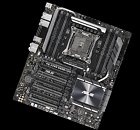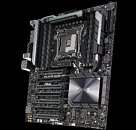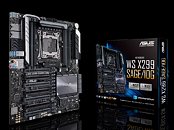- Joined
- Oct 9, 2007
- Messages
- 47,638 (7.44/day)
- Location
- Dublin, Ireland
| System Name | RBMK-1000 |
|---|---|
| Processor | AMD Ryzen 7 5700G |
| Motherboard | Gigabyte B550 AORUS Elite V2 |
| Cooling | DeepCool Gammax L240 V2 |
| Memory | 2x 16GB DDR4-3200 |
| Video Card(s) | Galax RTX 4070 Ti EX |
| Storage | Samsung 990 1TB |
| Display(s) | BenQ 1440p 60 Hz 27-inch |
| Case | Corsair Carbide 100R |
| Audio Device(s) | ASUS SupremeFX S1220A |
| Power Supply | Cooler Master MWE Gold 650W |
| Mouse | ASUS ROG Strix Impact |
| Keyboard | Gamdias Hermes E2 |
| Software | Windows 11 Pro |
ASUS today introduced the WS X299 SAGE/10G, a step up variant of the WS X299 SAGE it launched back in Q4-2017. As you can tell from the model name, this board's star-attraction is 10 Gbps Ethernet. It features not one, but two 10 GbE interfaces, replacing the dual 1 GbE interfaces of the original. These interfaces aren't backed by low-cost controllers, but the Intel X550-AT2 "Sageville," which is an $80 chip by itself, and drives both interfaces.
ASUS also used the opportunity to improve the CPU VRM a bit. Although it's still the same combination of chokes and MOSFETs, pulling power from two 8-pin EPS connectors, ASUS improved the secondary VRM heatsink, which pulls heat from the main heatsink over a flattened heat-pipe. This heatsink is now made of a dense aluminium fin-stack like the main heatsink, a section of which protrudes all the way to the rear I/O shield. The rear I/O now consists of four USB 3.1 gen 1 ports, two USB 3.1 gen 2 ports (including a type-C port), and the 8-channel HD audio cluster, besides the two 10 GbE ports. The rest of the board's feature-set is unchanged from the original. We expect a $100 premium over the original's price.




View at TechPowerUp Main Site
ASUS also used the opportunity to improve the CPU VRM a bit. Although it's still the same combination of chokes and MOSFETs, pulling power from two 8-pin EPS connectors, ASUS improved the secondary VRM heatsink, which pulls heat from the main heatsink over a flattened heat-pipe. This heatsink is now made of a dense aluminium fin-stack like the main heatsink, a section of which protrudes all the way to the rear I/O shield. The rear I/O now consists of four USB 3.1 gen 1 ports, two USB 3.1 gen 2 ports (including a type-C port), and the 8-channel HD audio cluster, besides the two 10 GbE ports. The rest of the board's feature-set is unchanged from the original. We expect a $100 premium over the original's price.




View at TechPowerUp Main Site








